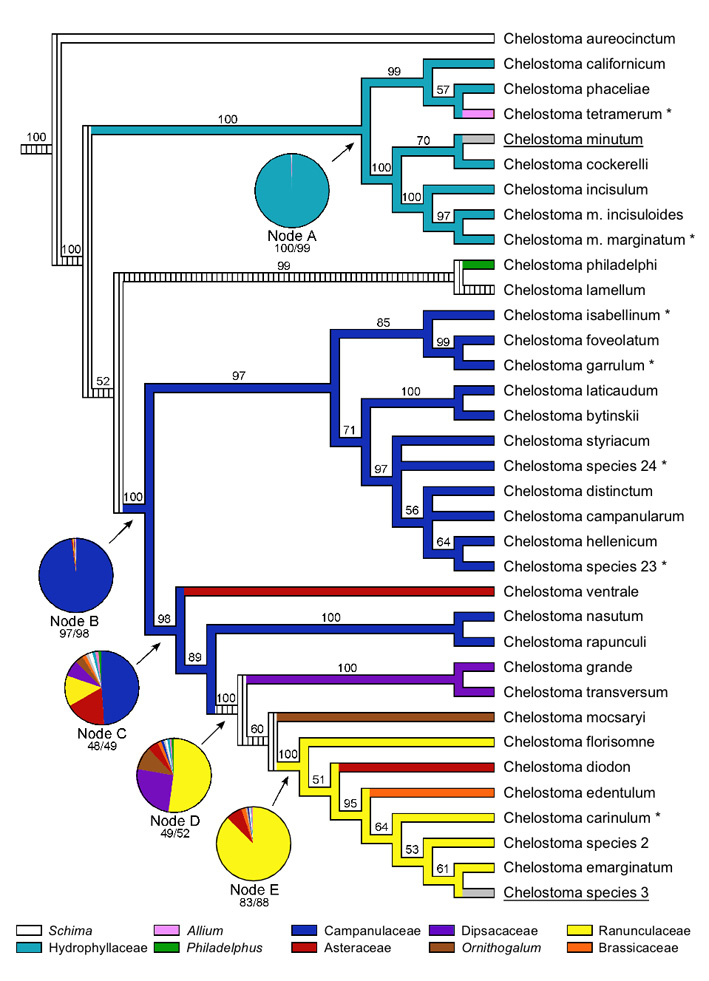Genus Chelostoma
Female of Chelostoma (Chelostoma) florisomne (Linnaeus, 1758) entering her nest in a preexisting burrow in dead wood; the abdominal scopa is filled with pollen of Ranunculus, the species’ exclusive pollen host. Foto A. Krebs.
Biogeography and diversity
The genus Chelostoma is distributed both in the Palaearctic and the Nearctic region, one single species reaches the Oriental region.
Currently, there are 55 described Chelostoma species worldwide, 46 of which occur in the Palaearctic.
Phylogeny and classification
The genus Chelostoma is the sister group of all other osmiine bees except Ochreriades, which might be either sister to the Osmiini or sister to the clade Megachilini+Anthidiini+Osmiini (Praz et al., 2008b).
A recent phylogenetic analysis based on four genes and a morphological dataset resulted in a well supported phylogeny for 35 Chelostoma species (Figure 1). This phylogeny differs from the subgeneric classification of Michener (2007) in three respects. First, the subgenus Foveosmia is not monophyletic as previously assumed, but was found to consist of three distinct clades: a North American clade, a Palaearctic clade and Chelostoma ventrale. Second, the North American Chelostoma (Prochelostoma) philadelphi and the eastern Palaearctic Chelostoma (Ceraheriades) petersi (= lamellum) are closely related, rendering their inclusion in two different subgenera unwarranted. Third, Chelostoma nasutum, formerly classified as a member of the subgenus Chelostoma s. str., belongs to the subgenus Gyrodromella.
Figure 1: Phylogenetic relationships within the genus Chelostoma. After Sedivy et al., Evolution, 62, 2487-2507, 2008.
The results of the phylogenetic analysis by Sedivy et al. (2008) leads to several classificatory changes compared to Michener (2007) and Ungricht et al. (2008). First, the Nearctic Foveosmia species will have to be united under a new subgeneric name as the Palaearctic Chelostoma foveolatum is the type species of Foveosmia. Second, Ceraheriades is here treated as a junior synonym of the subgenus Prochelostoma. Third, Chelostoma ventrale is moved from the subgenus Foveosmia to subgenus incertum. Its phylogenetic position varied depending on the analysis: it was either sister to the subgenus Gyrodromella or sister to the clade Gyrodromella+Chelostoma.
Subgeneric classification of the Palaearctic Chelostoma species as adopted in the present catalogue:
Chelostoma s. str. with 14 described species
Eochelostoma with 1 described species
Foveosmia with 18 described species
Gyrodromella with 8 described species
Prochelostoma with 4 described species
subgenus uncertain with 1 described species
Nesting biology
Information on the nesting biology is available for 11 Chelostoma species belonging to five clades from both the Palaearctic and the Nearctic region (A. Müller, C. Praz, J. Neff, G. Le Goff and C. Sedivy, unpublished). All species were observed to nest in preexisting cavities, mainly in insect burrows in dead wood or in hollow stems. Both cell partitions and nest plug are constructed from mud. In some (all?) species, nectar is used to moisten the mud. Most species integrate tiny pebbles, sand grains or other small particles in the outer surface of the plug, sometimes also in the cell partitions.
Flower preferences
A recent study on host-plant choice in bees of the genus Chelostoma on a worldwide scale revealed that the great majority of species are oligolectic at the level of plant family or genus (Sedivy et al., 2008). Only 2 out of 35 investigated species were found to be polylectic, harvesting pollen on at least five and three plant families, respectively. The oligolectic species restrict pollen foraging to Campanulaceae (13 species), Hydrophyllaceae (6), Ranunculaceae (4), Asteraceae (2), Dipsacaceae (2), Brassicaceae (1), Allium (Alliaceae) (1), Ornithogalum (Asparagaceae) (1), Philadelphus (Hydrangeaceae) (1) and Schima (Theaceae) (1). One additional species is possibly oligolectic on Philadelphus as well.
Oligolecty is the ancestral state in the genus Chelostoma and the two polylectic species evolved from oligolectic ancestors (Figure 2). The specialized host-plant associations were found to be highly conserved: except for two independent specializations to the Asteraceae, switches to all other host plant taxa happened only once. Most remarkable in this respect is the utilization of the same host, i.e. Philadelphus, by both the North American Chelostoma philadelphi and the Chinese Chelostoma petersi (= lamellum), indicating a floral host choice that might have been conserved for several million years.


